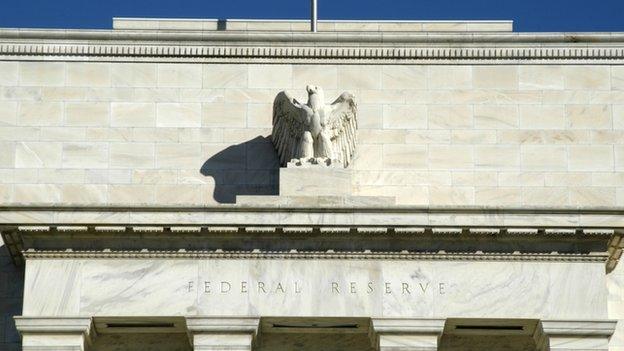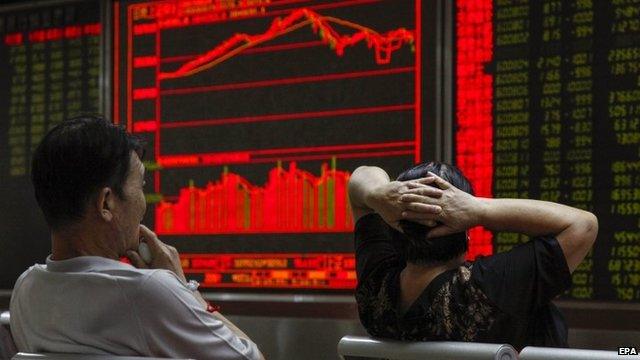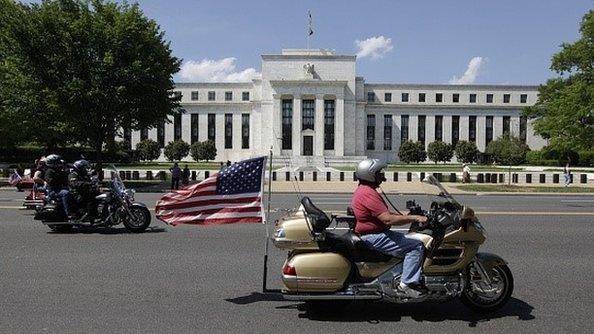What next for the global economy after China market woes?
- Published

What does heavy weather on the Chinese markets mean for the global economic climate?
It's been a rough August for investors. As has now been repeated ad nauseam, trillions of dollars have been wiped off global stock markets.
And that's left many questioning the underlying health of the global economy and wondering what comes next.
At heart, anyone grappling with this issue is really asking themselves three inter-related questions: how sharp is China's slowdown? What happens next to commodities? And when will the US Federal Reserve raise interest rates?
The direction of China's stock market is very much a third order issue - despite all the attention over the last week.
It matters little to investors outside China, as foreign ownership is still very limited - except perhaps as a gauge of sentiment.
It matters only a little more to Chinese investors - who are still a tiny subset of the Chinese people.
Its wild gyrations certainly don't tell us much about the underlying health of the Chinese economy.
So on to the first real question - how sharply has China slowed? Growth is certainly down from the double digit levels seen in the last decade. Officially the economy is growing at a still healthy 7% a year, but many independent analysts put the real number at closer to 5%.
That is still a healthy rate of growth for a country at China's stage of development - and given that China's economy is now much bigger than it was, 5% in 2015 contributes to global demand as much as 10% of a much smaller economy did earlier in the century.
How China slowed global markets - in 90 seconds
China's economy was always going to slow, but to understand the panic about this (and panic really is the word) one has to assume one of two things.
Either investors hadn't really previously discounted the fact that growth would really slow, or they are worried that the slowdown is sharper - something below 5%.
The latest bout of global risk aversion was kicked off by China's surprise decision to devalue its currency against the dollar.
Many took that as a sign of panic amongst Chinese policy makers - an attempt to kickstart exports and boost growth.
The decision was badly communicated and coincided with thin (and usually more volatile) August markets.
But for what it's worth, it strikes me as a fundamentally sensible move to partially uncouple the renminbi (RMB) from a rising dollar at a time when the dollar is likely to continue rising and other Asian currencies are weak.
That doesn't amount to an abandonment of China's "rebalancing" away from exports and investment and towards consumption, but a prudent step to take more control of their own monetary policy rather than being shackled (through a semi-pegged currency) to steps taken by the US Federal Reserve.
Bad Chinese manufacturing data last week rekindled those fears about the extent of the slowdown, but other data (especially consumption) point to healthier growth.
Weak demand for commodities
If growth is chugging along at 5%, then China has the difficult task of managing an economic transition and the shape of the world economy will begin to shift but fundamentally global growth isn't in danger. If though it's actually as low as 3% or even 1%, then the recent asset price falls are only the start.
Secondly, there's the question of commodities - and especially oil.
Commodity prices are at their lowest level since 1999. This is the core of the debate between the "deflationists" and the "reflationists".
To some that signals a world economy in serious trouble - weak demand for commodities signalling a slowdown in growth.
But to others this is mainly a supply side story - just look at oil, where US production has soared.
And cheaper commodities create what might be counter-intuitively thought of as "disinflationary force for reflation" - lower fuel and food prices boost real household disposable incomes, allowing more money to spend on other goods. Cheap petrol has been a motor of UK and European growth this year.
It certainly looks like Saudi Arabia's decision to maintain high production levels last year - read by many as an attempt to drive higher-cost US shale producers out of the market - has failed.
US shale really has two motors.
The first was high oil prices which made production economically tenable - that motor has failed.
US shale producers get efficient
But there was a second: easy access to credit to maintain cash flows and finance growth. And that motor, despite some signs of spluttering, still seems to be working.
Faced with lower prices, US producers are focusing on their best fields and raising their efficiency.
If commodity prices stay low then - all things being equal - this is a boon to importers in developed countries and a drag on emerging economy exporters.
Finally there's the question of when the US Federal Reserve will raise interest rates. The markets had been expecting that to happen in September - but that now looks less likely.
Market turmoil, slower global growth, weaker commodity prices and a stronger dollar (and hence less inflationary pressure) all give ammunition to those urging the Fed to wait.
On the other hand, to back down isn't cost free.
It may appear to "reward" bad behaviour in the markets - the Fed has many responsibilities but supporting stock prices isn't one of them.

When will the US Federal Reserve raise interest rates?
The central bank may be reluctant to delay if it is seen as an attempt to do this - which might encourage excessive risk taking in the future.
Managing the transition from near-zero rates to more "normal" policy was always going to be tricky. The Fed (like other monetary policy makers) has staked a lot on communication - by making clear that rates would rise in a gradual and controlled way to a lower level than in the past it sought to manage the fallout from a change in policy.
To delay hiking now may damage the credibility of that communication effort (a September rise having been well flagged in advance) and make the eventual task harder.
Many economists are now pushing their Fed hike-timing estimates out to December or even March next year. A lot may depend on how the markets play out in the weeks ahead.
These are the three real questions facing the global economy.
It's easy to get caught up in moves in the markets over the course of a single day or how currencies and stock indices performed over a week.
Global recession unlikely
I know this as I get caught up in this most days.
But it's always worth stepping back and looking at the big picture.
UK and US growth is relatively solid - not spectacular but solid. The Eurozone seems to be staging a weak recovery - though better than other years, supported by aggressive monetary policy.
Low commodity prices are an almost unambiguously good thing for the developed world.
But alongside that healthier picture for the developed world is a much weaker one for the emerging world.
Global growth still hasn't returned to the levels seen before 2008 and maybe it won't.
The pattern of global growth is changing. But it doesn't look like we are the verge of another global recession.
- Published25 August 2015

- Published25 August 2015
- Published24 August 2015

- Published17 June 2015

- Published2 March 2015